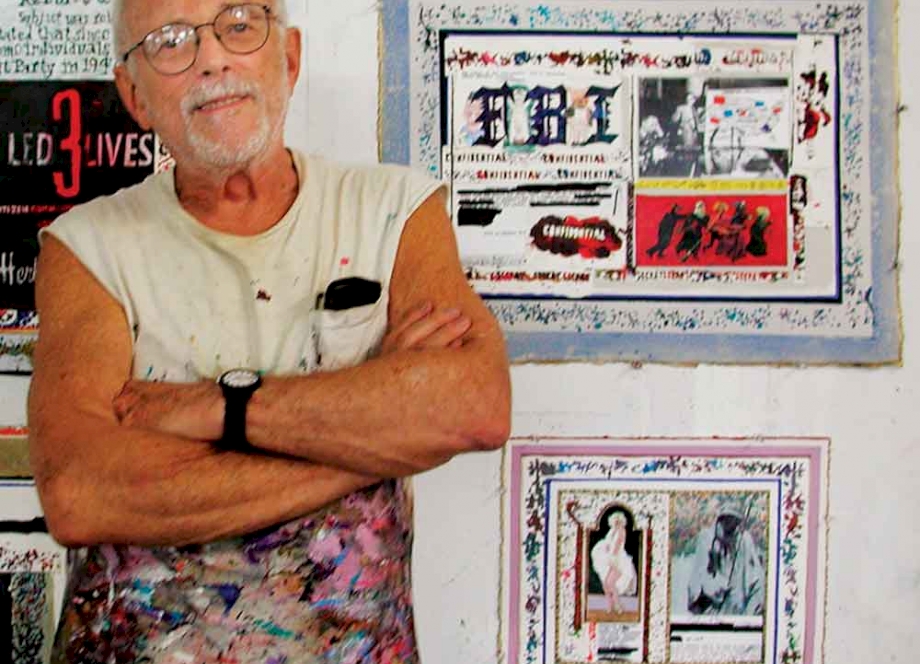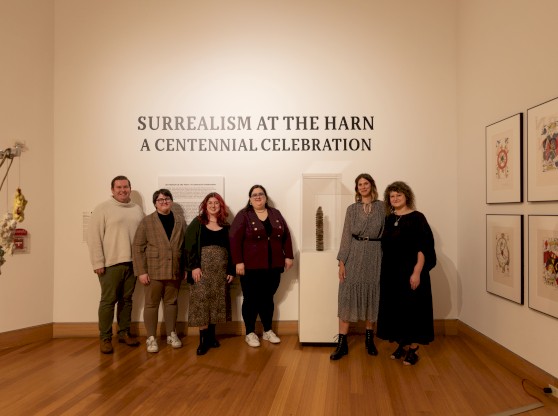When School of Art + Art (SAAH) History Professor Richard Heipp took his students on a visit to the New York City studio of Arnold Mesches almost twenty years ago, he never imagined that Mesches would one day relocate to Gainesville.
As an active painter for over seventy years, Mesches, who passed away last month, left a profound impression on the art world. His work drew the attention of many — including the F.B.I, who tracked his work and kept files on him for over twenty-five years during the McCarthy era. This became the impetuous for Mesches’ most well-known series, “The F.B.I. Files,” which included dozens of the collaged files and debuted at the Museum of Modern Art’s P.S. 1 in Queens, before touring nationally.
Mesches’ work has been shown at the Metropolitan Museum of Art, the Library of Congress, and the National Gallery of Art, among many others. His work was socially and politically provocative, and he was a talented and respected working artist.
He was also, according to Heipp, the hardest working artist he has ever known.
“Arnold was infamous for putting everyone he ever met on his mailing list,” Heipp said with a laugh. “And once you were on it, you got an email about every single show he did.”
Around 2002, however, Mesches reached out to Heipp for an entirely different reason.
“He called me up on a Sunday morning and asked what it would be like to live in Gainesville,” Heipp recalled.
Mesches’ wife, the novelist Jill Ciment, had been offered a job teaching Creative Writing at the University of Florida. The two relocated from their home in New York, and divided their time between Gainesville and New York up until Mesches’ death on November 5.
Suddenly, the Gainesville and UF community had gained a valuable resource and ally. Mesches was a friend to faculty and a mentor to students, and his talent and experience were second-to-none. He taught graduate classes and seminars, joined critique panels, and in 2010, received an Honorary Degree from the College of the Arts.
When asked about Mesches’ contribution to the College and SAAH, Heipp always comes back to one word: generous.
“Arnold was generous with his time, and he was generous with his advice,” Heipp said. “Whenever any of the faculty would ask him to come in for critiques, or to have students tour his studio, he would always say yes. And if you were having an exhibition, Arnold would always send a postcard congratulating you.”
Mesches was 93 when he passed, and he had never stopped working. His studio was a wealth of insight for the students who toured it, and Mesches himself was an invaluable mentor.
Jeremy Mikolajczak (MFA ’07) was a student of Mesches’ as he pursued his Master’s in Visual Arts, but over the years, their relationship evolved into that of lifelong friends. Mikolajczak recalls Mesches’ for his wealth of advice, all of which was rooted in honesty and a desire to see his students succeed.
“No one else had that level of impact on students,” Mikolajczak said. “Arnold was always candid, and some of his advice might have been harsh, but he was the most candid and caring mentor you could ask for.”
When Mikolajczak took on the position of executive director and chief curator at Miami-Dade College’s Museum of Art and Design, he was honored to help organize Arnold Mesches: A Life’s Work, an overarching retrospective of Mesches’ career. The 2013 show included everything from Mesches’ first painting to his last series, an opportunity Mikolajczak called “timely and needed.”
Considering the length and breadth of Mesches’ career, the show was understandably huge. It stretched across Miami-Dade’s campus, from the Freedom Tower to three separate galleries. Mikolajczak worked alongside chief curator Kim Levin, as well as Mesches and Ciment, to make the show possible.
“It’s almost unheard of to see a social-realist painter of Arnold’s caliber who worked for as long as he did,” Mikolajczak acknowledged. “The exhibition was a way to show his long and industrious career.”
Mesches is survived by his wife, two children, Paul and Susan, and his two grandsons. After his death, the New York Times published an obituary detailing his life and work, showing exactly how long and industrious his career really was.
Mesches’ work provided vital social commentary during some of the most distressing periods in U.S. history. Perhaps lesser known — but just as important, to those who knew him — were his innumerable and invaluable contributions to the UF community.
“Arnold was part of our family,” Heipp said. “He was a real artist in every sense of the word — in terms of commitment to craft, vision, and the art world – and we were so lucky to have him here.”



